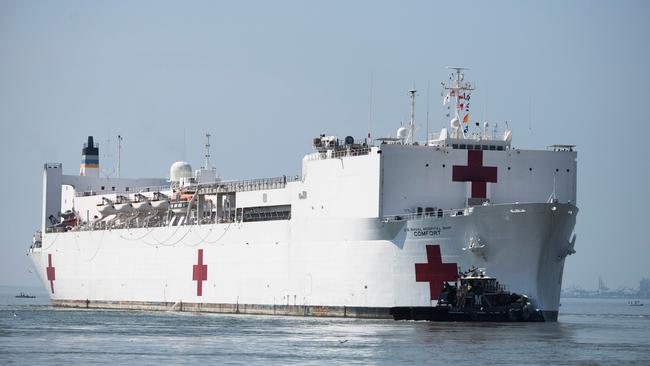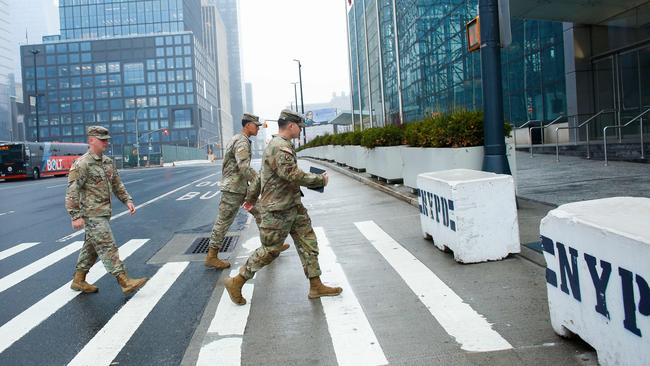Coronavirus US: New York's grim death count
New Yorkers are watching the city drastically transform before their eyes as the coronavirus wreaks havoc on the city - which is now at the US epicentre of the pandemic.

It doesn't take long to grow accustomed to the sound of sirens continuously blaring in New York City.
At first they seem ridiculously loud, but after a while, you hardly even notice them.
That was until recent weeks when the Big Apple became the US epicentre of the coronavirus pandemic and the streets all but cleared out as infections surged.
As of Sunday, at least 2,191 deaths were reported across the country, with at least 124,686 cases. More than 59,513 of those cases, including 965 deaths, were in New York state.
Currently, 8,503 people in the state are in hospital — with 2,037 in intensive care units.
The sirens are now impossible to ignore as they pierce through the silence of Manhattan's abandoned major avenues and echo down its empty streets at all hours of the day. Times Square was still illuminated Sunday by advertisements flashing on giant screens, but the hordes of tourists they're targeted at have long gone.
In the heart of a typically bustling Times Sq, at 9pm on a Friday night @newscomauHQ #CoronavirusUSA pic.twitter.com/Qkyfy9MDfI
— Megan Palin (@Megan_Palin) March 21, 2020
But many of those who remain in the city holed up inside their tiny apartments, like millions of other people around the world, are on edge. Those who dare venture out to exercise or purchase essentials exchange cautious looks as they pass strangers, many wearing surgical masks and plastic gloves, some ranting out loud about "social distancing" and "self-isolation". Signs have been pinned to residential apartment building elevators, warning residents to travel in the lifts "one at a time" and in some cases, visitors are restricted access by management.
On Sunday, New York governor Andrew Cuomo announced New Yorkers will be required to work from home for at least another two weeks.
Speaking at his daily press conference, Mr Cuomo said he was extending his "New York State on pause" executive order until April 15. It will cap one month of self-isolation for non-essential works - and that's highly likely to again be extended.
The announcement came after Donald Trump decided against imposing a broad lockdown on New York and its neighbours after a strong push back from political leaders and warnings of the panic it could start.
"A quarantine will not be necessary," the US President tweeted about eight hours after he stunned the state with a proposal to place it under quarantine to prevent residents from leaving.
READ MORE: Follow more coronavirus news
New Yorkers are famously unflinching in the face of adversity or even just the plain bizarre, yet there’s an increasing sense of dread, in some cases panic, over what's to come. All around them, the city is changing before their eyes, as extreme measures to reduce contagion are adopted and preparations are made to respond to mass casualties. It's necessary and important work that not every city can afford to carry out but it's what it all signifies that threatens to bring some people undone. Refrigerated trucks and pop-up tent morgues line streets outside large medical facilities, ready to store dead bodies as the permanent buildings overflow.

Demand also dramatically outweighs supply when it comes to hospital beds and medical supplies, including life-saving ventilators. That's why sprawling convention centres and other state-of-the-art buildings in the heart of New York city are being converted into makeshift hospitals in record time. Further to that, a navy vessel has been deployed from Virginia to act as a floating hospital in New York Harbour - it's expected to arrive on Monday. It will provide about 1000 extra beds, taking the pressure of hospitals overwhelmed with an influx of coronavirus patients. Americans have repeatedly been warned not to call emergency services for medical help unless absolutely necessary, such is the strain on the health system.

Health officials say they fear New York will follow the catastrophic path chartered by Italy, with health workers risking their lives on the frontline of the crisis and hospitals desperately short of protective equipment.
New York Mayor Bill de Blasio said Sunday the city has enough medical supplies, with the exception of ventilators, to last until April 5.
This afternoon, President @realDonaldTrump will deliver remarks at the Naval Station Norfolk send-off for the #USNSComfort.
— The White House (@WhiteHouse) March 28, 2020
Watch LIVE: https://t.co/EmsdctGWtd pic.twitter.com/EMaYI5HIlN
Normally, every individual hospital operates on its own, and there is a wall between public and private hospitals.
— Andrew Cuomo (@NYGovCuomo) March 29, 2020
We have to change that structure quickly.
We need all our hospitals to work together.
It's all hands on deck.
HOW WE GOT HERE
The coronavirus is believed to have originated in the Chinese city of Wuhan before the first few people infected travelled across vast oceans, allowing the virus to spread to people all over the globe.
In New York, a highly dense area, cases went from a handful to more than 50,000 in a matter of a few weeks. The state is now grappling to flatten the curve as it approaches the apex which it is expected to reach in about three weeks. The coronavirus could claim hundreds of thousands of lives and infect millions in the US alone, according to Dr Fauci.
Despite the growing coronavirus numbers, Mr Trump said he wants lockdowns lifted by April 12, in an effort to save the economy.
Vice President Mike Pence, who leads the Coronavirus Task Force, said he will give Mr Trump a recommendation regarding that decision in the coming weeks.
"We're going to protect our vulnerable Americans but in the midst of doing all of that, as the president said, his desire is to put America back to work, to open our country up as soon as we can responsibly do that and the team this week has been bringing those recommendations to him,” Mr Pence said on Saturday.
For now, many wait anxiously, wondering if or when it will come for them. The risk of contracting the virus in New York is high. Experts say 50-60 per cent of the population is likely to contract the disease although most will exhibit only mild symptoms.
It's an outcome that other countries in the earlier stages of the outbreak are trying to avoid.
"Every single Australian needs to take this seriously or community transmission could get out of control and we could have a situation as terrible as even they are seeing in the US at the moment," Australia Prime Minister Scott Morrison said over the weekend.
The city that never sleeps taking a nap @newscomauHQ #coronavirus pic.twitter.com/W39OCFwstN
— Megan Palin (@Megan_Palin) March 20, 2020
In a press conference on Sunday local time, New York governor Andrew Cuomo moved to reassure those who were "frightened" and looking for a light at the end of the tunnel.
“We have made it through far harder things … we are going to be ok,” Mr Cuomo said.
“We specialise in stamina and strength in instability.
“I’m not going to say to anyone you’re not going to see people pass away…you will… that is beyond our control.”



